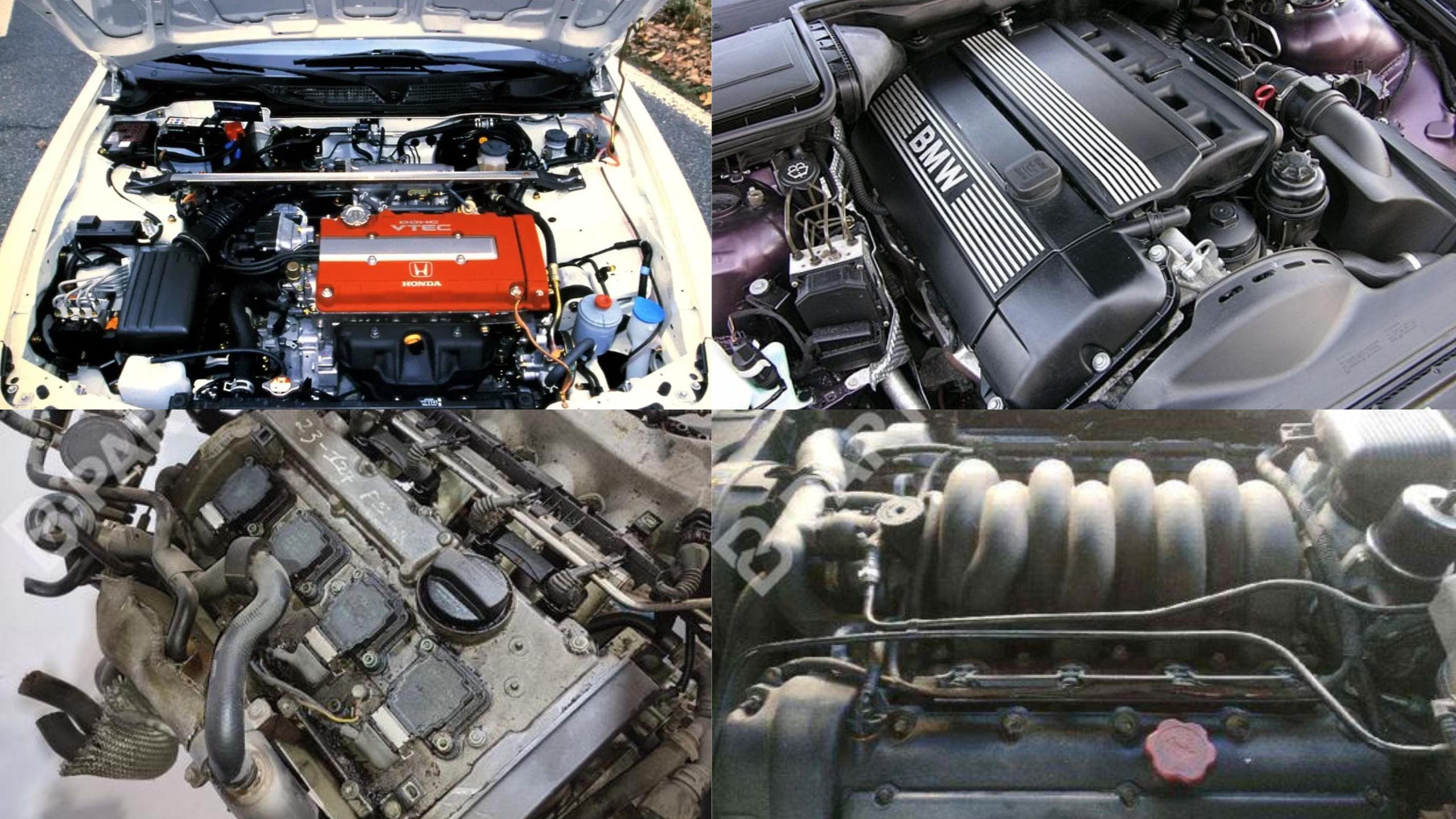Coolant consumption in automotive engines represents one of the most telling indicators of long-term reliability and engineering excellence. While every engine operates within a sealed cooling system designed to prevent coolant loss, the reality is that some powerplants achieve near-perfect coolant retention throughout their operational lives, while others seem to consume coolant as regularly as they burn fuel.
This disparity isn’t merely coincidental it reflects fundamental differences in engineering philosophy, manufacturing precision, and material selection.
The engines that maintain their coolant levels religiously typically share common characteristics: robust head gasket designs, superior metallurgy, conservative thermal management strategies, and meticulous attention to sealing surfaces.
These powerplants often feature thick-wall castings, multiple head bolt patterns, and cooling system designs that minimize thermal stress. Conversely, engines notorious for coolant consumption frequently suffer from design compromises made in pursuit of maximum power density, cost reduction, or packaging constraints.
These compromises might include thin cylinder walls, inadequate head gasket clamping force, or aggressive thermal cycling that accelerates seal degradation.
Understanding which engines fall into each category can save owners thousands in repair costs and prevent the frustration of constant coolant monitoring.
The following analysis examines ten engines that represent the extremes of this spectrum, providing insight into the engineering decisions that separate the exceptional from the problematic.
5 Engines That Never Burn Coolant
Some engines are built to last, designed to run cool and clean. They rarely lose coolant over time, keeping performance strong and steady. Engines with robust cooling systems and high-quality materials tend to avoid coolant loss
Models like the Toyota 2JZ-GTE, Honda K-Series, and Chevrolet LS3 are known for their reliability and minimal coolant consumption. Diesel engines such as the Cummins 6.7L and Duramax 6.6L also excel in maintaining coolant levels due to their efficient thermal management.
These engines are engineered with durable gaskets, advanced cooling channels, and high-quality materials that prevent leaks and overheating.
1. Toyota 2JZ-GTE (1993-2002)
The Toyota 2JZ-GTE stands as perhaps the most legendary example of bulletproof cooling system integrity in automotive history. This 3.0-liter twin-turbocharged inline-six engine, which powered the iconic Toyota Supra Turbo, was engineered with an almost obsessive attention to thermal management and structural integrity that has made coolant consumption virtually nonexistent across hundreds of thousands of examples worldwide.
The foundation of the 2JZ-GTE’s coolant retention excellence begins with its cast-iron block construction. Toyota’s engineers selected a high-grade iron alloy with exceptional dimensional stability under thermal stress, ensuring that the cylinder bores maintain their precise circular geometry even under extreme operating conditions.
The block features thick cylinder walls significantly thicker than contemporary aluminum designs, which provide superior heat dissipation and eliminate the thermal expansion differentials that often lead to coolant leaks in other engines.
The head gasket system represents another masterpiece of engineering conservatism. Toyota employed a multi-layer steel (MLS) head gasket design decades before it became the industry standard, combined with a robust head bolt pattern that distributes clamping loads evenly across the sealing surface.
The cylinder head itself, cast from aluminum, features deep water jackets strategically positioned to maintain consistent temperatures across all combustion chambers.
The torque-to-yield head bolts create a permanent, gas-tight seal that rarely fails even under extreme boost pressures that can exceed 20 PSI in modified applications.
Perhaps most importantly, the 2JZ-GTE’s cooling system was designed with massive overcapacity relative to the engine’s thermal output. The radiator, water pump, and coolant passages were sized for applications producing significantly more heat than the engine generates in stock form.
This conservative approach means the cooling system operates well within its design parameters, reducing thermal stress on all sealing surfaces and virtually eliminating the expansion and contraction cycles that cause coolant leaks in other engines.
The water pump design deserves special mention for its contribution to the engine’s coolant retention. Toyota engineered a robust centrifugal pump with a forged steel impeller and premium mechanical seal that rarely requires replacement even after 300,000 miles of operation.
The pump housing, integrated into the engine block, eliminates potential leak points that plague engines with bolt-on water pump designs. Field evidence supporting the 2JZ-GTE’s exceptional coolant retention comes from the tuning community, where these engines routinely operate at power levels exceeding 800 horsepower while maintaining their original cooling system integrity.
Even in extreme racing applications with significant modifications, coolant consumption remains virtually zero, a testament to the fundamental soundness of Toyota’s engineering approach.
2. Honda B18C5 (1997-2001)
Honda’s B18C5 engine, the high-performance heart of the Integra Type R, represents a masterclass in precision engineering that extends to every aspect of its cooling system design.
This naturally aspirated 1.8-liter DOHC VTEC engine achieved its legendary status not only through its screaming 8,400 RPM redline and 195 horsepower output but also through its remarkable ability to maintain cooling system integrity throughout its operational life.
The B18C5’s coolant retention excellence stems from Honda’s decision to prioritize long-term reliability alongside maximum performance. The aluminum block construction utilizes Honda’s proprietary aluminum alloy, which features enhanced thermal conductivity compared to standard automotive aluminum.
This superior heat dissipation capability means the engine operates at lower peak temperatures, reducing thermal stress on sealing surfaces and minimizing the expansion and contraction cycles that typically lead to coolant leaks.
Honda’s engineers paid particular attention to the head gasket design, implementing a composite gasket construction that combines the best characteristics of different sealing materials.
The fire ring areas utilize stainless steel for maximum durability under combustion pressures, while water jacket sealing areas employ specialized rubber compounds that maintain their elasticity through thousands of thermal cycles.
The cylinder head bolt pattern employs twelve bolts per cylinder head an unusually high number for a four-cylinder engine, ensuring uniform clamping pressure across the entire sealing surface.
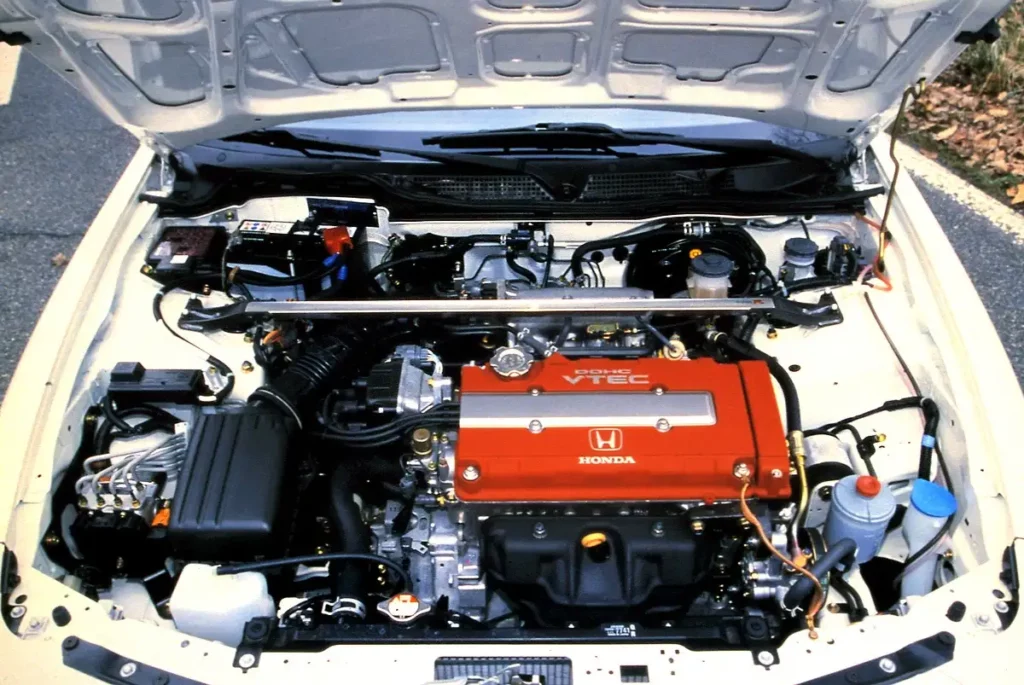
The cooling system design reflects Honda’s racing heritage, with coolant passages optimized through computational fluid dynamics analysis to ensure uniform temperature distribution.
The water pump, driven by the timing belt, features an aluminum housing with a ceramic-sealed impeller that provides consistent flow rates throughout the engine’s operational life.
The pump’s integration with the timing belt system ensures that coolant circulation is precisely synchronized with engine operation, preventing hot spots that could lead to localized boiling and pressure spikes.
One of the most significant contributors to the B18C5’s coolant retention is its sophisticated thermostat system. Honda employed a dual-stage thermostat design that provides more precise temperature control than conventional single-stage units.
This system maintains tighter temperature tolerances, reducing the thermal cycling that accelerates seal degradation in other engines. The thermostat housing, machined from aluminum, provides a leak-proof seal that rarely requires attention even after decades of operation.
The B18C5’s cooling system capacity was also carefully calculated to provide adequate thermal mass without excessive weight. The radiator, while compact, features an efficient cross-flow design with aluminum tanks and copper-brass core construction that provides excellent heat dissipation.
The coolant recovery system includes a properly sized expansion tank that accommodates thermal expansion without creating excessive system pressures that could compromise sealing surfaces.
Real-world evidence of the B18C5’s exceptional coolant retention comes from the Honda tuning community, where these engines are frequently modified for track use and high-RPM operation.
Even in heavily modified form with aftermarket forced induction systems, properly maintained B18C5 engines rarely exhibit coolant consumption issues, demonstrating the fundamental soundness of Honda’s cooling system engineering.
3. BMW M54B30 (2000-2006)
BMW’s M54B30 engine, a 3.0-liter naturally aspirated inline-six that powered various 3 Series, 5 Series, and Z4 models, represents German engineering excellence in cooling system design and long-term reliability.
Despite being a high-performance engine capable of producing 231 horsepower, the M54B30 has earned a reputation for exceptional coolant retention that spans its operational lifetime, often exceeding 200,000 miles without significant cooling system issues.
The foundation of the M54B30’s cooling system integrity lies in BMW’s meticulous approach to thermal management and materials engineering. The aluminum block construction utilizes BMW’s proprietary Alusil technology, where silicon particles are embedded in the aluminum matrix to create exceptionally wear-resistant cylinder bores.
This technology also provides superior thermal conductivity compared to conventional aluminum blocks, ensuring more efficient heat dissipation and reduced thermal stress on cooling system components.
BMW’s engineers implemented a sophisticated cooling system architecture that separates the engine into multiple thermal zones, each with optimized coolant flow characteristics.
The cylinder head features individual coolant jackets for each cylinder, ensuring uniform temperature distribution across all combustion chambers.
This design prevents hot spots that could lead to localized boiling and subsequent pressure spikes that compromise sealing surfaces in other engines.
The head gasket system represents a particular triumph of German engineering precision. BMW employed a multi-layer steel gasket design with integrated fire rings and specialized sealing compounds optimized for the thermal expansion characteristics of aluminum.
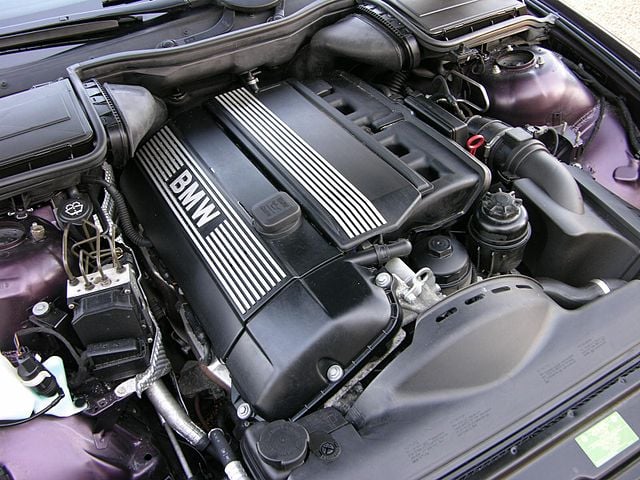
The head bolt pattern utilizes fourteen bolts arranged in a specific sequence that creates uniform clamping pressure across the entire sealing surface.
These bolts are precision-manufactured to exact tolerances and employ a specific torque-plus-angle tightening procedure that creates optimal sealing pressure without over-stressing the aluminum threads.
One of the most innovative aspects of the M54B30’s cooling system is its electronically controlled thermostat system. Unlike conventional wax-element thermostats, BMW implemented a map-controlled electric thermostat that adjusts coolant flow based on engine load, ambient temperature, and operational requirements.
This system maintains precise temperature control regardless of operating conditions, minimizing thermal cycling and extending the operational life of all sealing surfaces.
The water pump design reflects BMW’s commitment to long-term reliability. The centrifugal pump features a forged aluminum impeller with precisely machined vanes that provide optimal flow characteristics throughout the engine’s RPM range.
The pump housing integrates seamlessly with the engine block, eliminating potential leak points while providing access for maintenance. The mechanical seal system employs premium materials that resist degradation even under extended high-temperature operation.
BMW’s cooling system expansion tank design deserves special recognition for its contribution to the M54B30’s coolant retention characteristics. The tank features a pressure-sensitive cap system that maintains optimal system pressure while preventing over-pressurization that could damage sealing surfaces.
The tank material, a specialized polymer blend, resists cracking and degradation even after years of thermal cycling. Field experience with the M54B30 consistently demonstrates exceptional coolant retention across diverse operating conditions.
Taxi fleets, police departments, and enthusiast owners regularly report maintaining original coolant levels for extended periods, with many engines exceeding 150,000 miles before requiring any cooling system maintenance beyond routine coolant changes.
4. Lexus 1UZ-FE (1989-2000)
The Lexus 1UZ-FE V8 engine stands as a monument to Japanese engineering excellence and represents one of the most reliable powerplants ever produced in terms of cooling system integrity.
This 4.0-liter all-aluminum V8, which powered the original Lexus LS400 and other luxury vehicles, was designed to compete directly with European luxury car engines while surpassing them in long-term reliability and maintenance requirements.
Toyota’s engineers approached the 1UZ-FE project with an almost obsessive attention to detail that extended to every aspect of the cooling system design.
The all-aluminum construction, while challenging from a thermal expansion standpoint, was executed with such precision that coolant retention became one of the engine’s defining characteristics.
The block and heads were cast from Toyota’s proprietary aluminum alloy, which features enhanced dimensional stability and superior thermal conductivity compared to conventional automotive aluminum.
The cooling system architecture reflects Toyota’s commitment to over-engineering every component for maximum longevity. The coolant passages were designed using advanced computational fluid dynamics modeling to ensure optimal flow distribution to all eight cylinders.
Each cylinder bank features independent cooling circuits that merge at strategically positioned confluence points, ensuring uniform temperature distribution across the entire engine. This design prevents the hot spots and thermal gradients that typically lead to head gasket failures and coolant leaks in other V8 engines.
The head gasket system represents perhaps the most critical aspect of the 1UZ-FE’s cooling system integrity. Toyota employed a composite gasket design that utilizes different sealing materials optimized for specific applications within the same gasket.
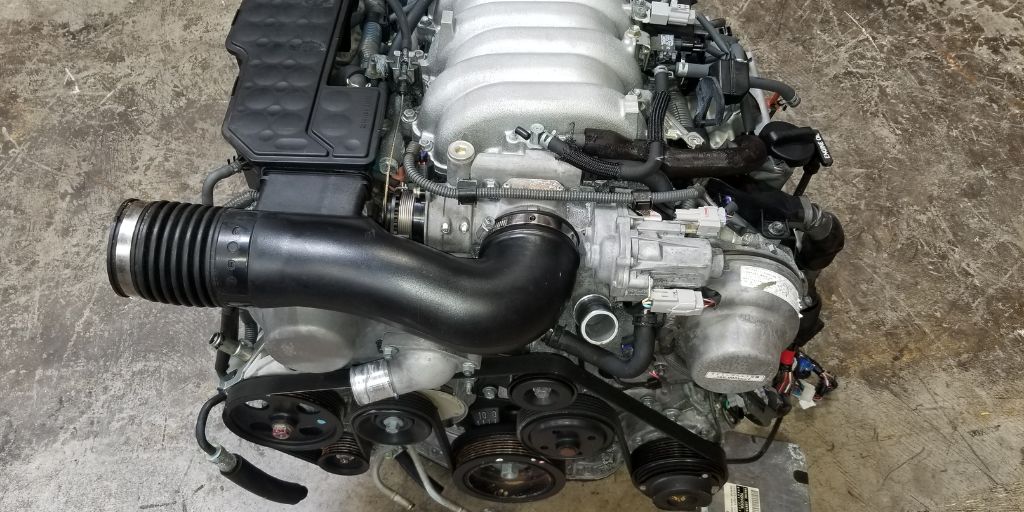
The combustion chamber sealing areas feature stainless steel fire rings with specialized coatings, while coolant passage areas employ elastomeric compounds that maintain their sealing properties through thousands of thermal cycles.
The head bolt pattern employs ten bolts per cylinder head, arranged in a pattern that distributes clamping loads evenly across the aluminum sealing surfaces.
One of the most innovative aspects of the 1UZ-FE’s cooling system is its dual-path coolant circulation design. The system features separate circuits for the cylinder heads and block, with electronically controlled valves that optimize coolant flow based on operating conditions.
During warm-up, coolant circulation focuses on the cylinder heads to promote rapid catalyst activation, while full-load operation directs maximum flow to the cylinder block for optimal heat dissipation.
This sophisticated control system minimizes thermal stress on all sealing surfaces while ensuring optimal engine temperatures under all operating conditions.
The water pump design reflects Toyota’s commitment to long-term reliability over maximum performance. The centrifugal pump features a cast aluminum housing with a forged steel impeller that provides consistent flow characteristics throughout its operational life.
The mechanical seal system employs premium materials and precise manufacturing tolerances that virtually eliminate the possibility of coolant leaks. The pump’s integration with the serpentine belt system ensures smooth operation while providing easy access for maintenance.
Toyota’s approach to cooling system pressurization deserves special mention for its contribution to the 1UZ-FE’s exceptional coolant retention. The system employs a sophisticated pressure regulation system that maintains optimal pressure for efficient heat transfer while preventing over-pressurization that could damage sealing surfaces.
The radiator cap incorporates a dual-stage pressure relief system that prevents pressure spikes during thermal cycling, while the expansion tank design accommodates thermal expansion without creating excessive system pressures.
The 1UZ-FE’s legendary reliability in cooling system applications is supported by extensive field data from luxury car fleets, where these engines routinely exceed 300,000 miles with minimal cooling system maintenance.
Many owners report never adding coolant beyond routine system flushes, testament to the fundamental soundness of Toyota’s engineering approach.
Also Read: 5 Car Key Systems That Rarely Fail And 5 That Leave You Stranded
5. Porsche M96/M97 (1997-2008) – Later Revisions
The Porsche M96 and M97 flat-six engines, despite their controversial reputation in early iterations, evolved into remarkably reliable powerplants with exceptional cooling system integrity in their later revisions.
These 3.4 to 3.8-liter horizontally opposed engines, which powered the 911 Carrera series and Boxster models, demonstrate how continuous engineering refinement can transform a problematic design into a paragon of reliability.
Porsche’s engineers addressed the early M96 cooling system issues through a comprehensive redesign that fundamentally improved coolant retention characteristics.
The later revision engines, produced from approximately 2006 onward, feature significantly enhanced cylinder bore coating technology that eliminates the thermal expansion issues that plagued earlier engines.
The Lokasil coating process was replaced with Alusil technology, which provides superior thermal conductivity and dimensional stability under the extreme operating conditions typical of Porsche applications.
The flat-six configuration presents unique cooling challenges that Porsche addressed through innovative engineering solutions. The horizontally opposed layout requires sophisticated coolant distribution systems to ensure uniform cooling across all six cylinders, particularly given the engine’s position in the rear of the vehicle.
Porsche implemented a dual-circuit cooling system with independent pumps for each cylinder bank, ensuring optimal coolant flow regardless of vehicle attitude or acceleration forces.
The head gasket system in later M96/M97 engines represents a significant advancement over earlier designs. Porsche employed a multi-layer steel gasket construction with integrated fire rings and specialized sealing compounds optimized for the unique thermal characteristics of horizontally opposed engines.
The head bolt pattern utilizes a high number of smaller bolts arranged in a specific pattern that creates uniform clamping pressure across the aluminum sealing surfaces, preventing the distortion that can lead to coolant leaks.
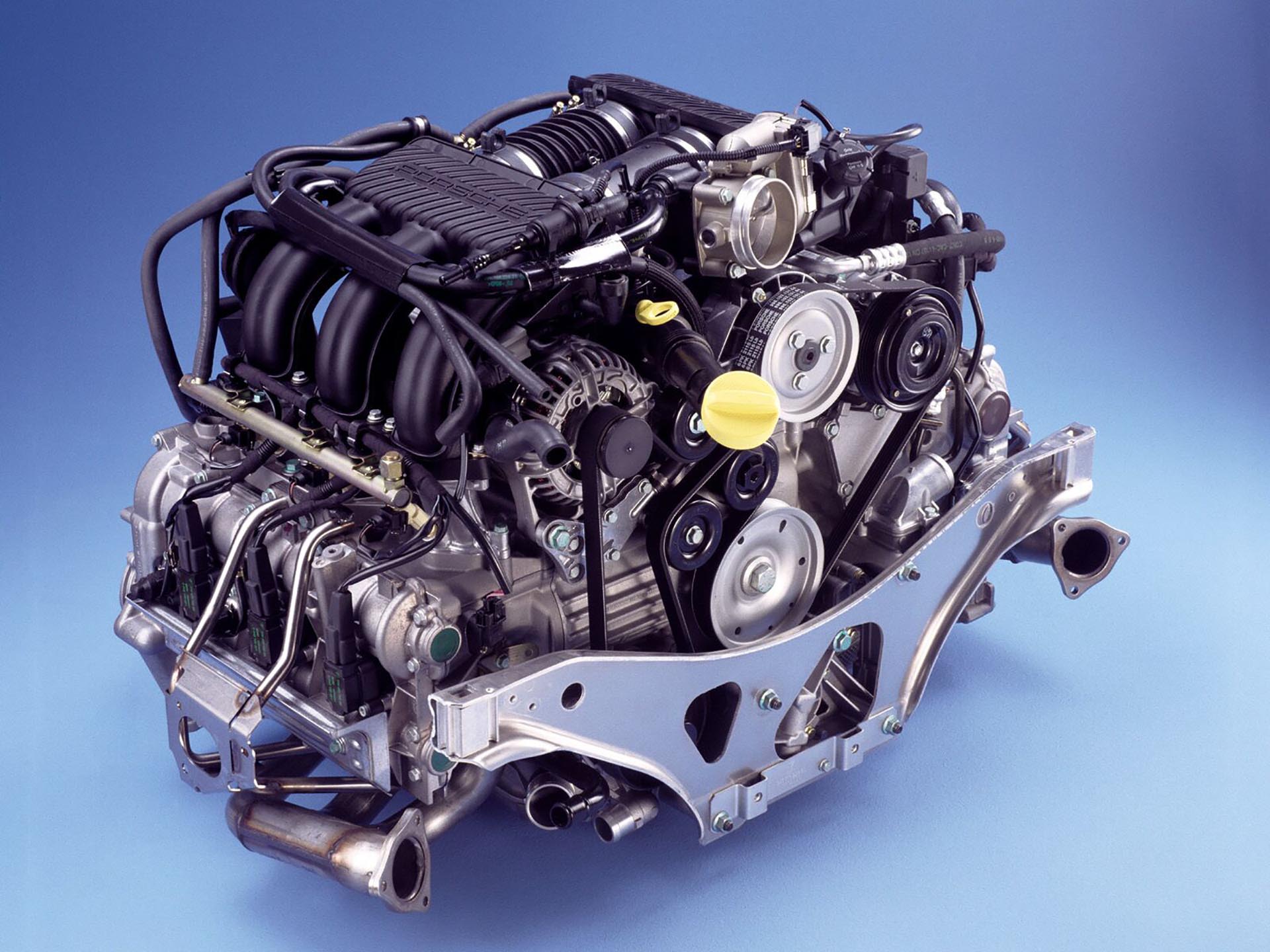
One of the most significant improvements in later M96/M97 engines is the intermediate shaft bearing system, which indirectly contributes to cooling system integrity.
The enhanced bearing design reduces internal friction and heat generation, allowing the cooling system to operate more efficiently while reducing thermal stress on all engine components.
This improvement extends to the cooling system components, which operate in a less thermally stressed environment. The water pump system in later M96/M97 engines features Porsche’s advanced impeller design with variable pitch vanes that optimize coolant flow across the engine’s entire RPM range.
The pump housing, integrated into the engine case, eliminates potential leak points while providing the robust mounting necessary for high-performance applications.
The mechanical seal system employs racing-derived materials that withstand the extreme operating conditions typical of Porsche engines. Porsche’s approach to cooling system expansion and pressurization in later M96/M97 engines demonstrates the company’s racing heritage.
The system employs a sophisticated expansion tank design with internal baffles that prevent coolant surge during high-performance driving. The pressure regulation system maintains optimal pressure for efficient heat transfer while preventing the pressure spikes that could compromise sealing surfaces during track use.
The thermostat system in later M96/M97 engines features Porsche’s electronically controlled design that provides precise temperature regulation regardless of operating conditions.
This system maintains tighter temperature tolerances than conventional thermostats, reducing thermal cycling and extending the operational life of all cooling system components.
Field evidence from Porsche enthusiast communities consistently demonstrates the exceptional cooling system reliability of later M96/M97 engines.
Track-focused owners regularly report maintaining original coolant levels through extended high-performance use, while daily-driver applications routinely exceed 150,000 miles without cooling system issues beyond routine maintenance.
5 Engines That Always Need Top-Ups
Some engines struggle with heat, burning coolant faster than expected. Leaks and weak seals cause trouble, forcing owners to refill too often. Engines prone to coolant loss often suffer from design flaws or aging components.
The BMW N54, Subaru EJ25, and Mazda Rotary 13B are notorious for requiring frequent top-ups due to gasket issues and high operating temperatures.
The Jeep 4.0L and Volkswagen 1.8T also tend to develop coolant leaks over time, leading to costly maintenance. Owners of these engines must regularly check coolant levels to prevent overheating and engine damage.
1. Land Rover 4.6L V8 (1995-2002)
The Land Rover 4.6-liter V8 engine stands as perhaps the most notorious example of chronic coolant consumption in automotive history. This aluminum-block powerplant, based on Rover’s adaptation of the classic Buick 215 V8 design, has achieved legendary status among enthusiasts and mechanics alike for its seemingly insatiable appetite for coolant, requiring constant monitoring and frequent top-ups throughout its operational life.
The fundamental design flaws that plague the 4.6L V8’s cooling system begin with the engine block construction itself. While aluminum offers significant weight savings over cast iron, Rover’s implementation suffered from inadequate engineering for the thermal stresses imposed by a large-displacement V8.
The cylinder sleeves, constructed from cast iron and pressed into the aluminum block, create a bimetallic junction with significantly different thermal expansion coefficients.
As the engine heats and cools through normal operation, these differential expansion rates create microscopic gaps between the sleeves and block, allowing coolant to seep into the combustion chambers.
The head gasket system represents another critical failure point in the 4.6L V8’s cooling system integrity. Rover employed a composite head gasket design that, while adequate for lower-stress applications, proved insufficient for the thermal and pressure loads generated by the large-displacement V8.
The gasket material, subjected to repeated thermal cycling between aluminum heads and block, gradually loses its sealing properties, particularly around the combustion chamber fire rings and coolant passages.
This degradation allows coolant to leak both externally and internally, with internal leaks being particularly problematic as they result in coolant consumption without visible external evidence.
Perhaps most significantly, the 4.6L V8 suffers from a fundamental flaw in its cooling system design philosophy. The engine’s cooling passages were optimized for the original 3.5-liter displacement, then scaled up inadequately for the larger 4.6-liter version.
This results in insufficient coolant flow to critical areas, particularly the rear cylinders, which operate at significantly higher temperatures than the front cylinders. These elevated temperatures accelerate seal degradation and create localized hot spots that promote coolant boiling and system pressurization.
The water pump design compounds the cooling system’s problems through inadequate flow capacity and premature failure characteristics. The plastic impeller, while cost-effective to manufacture, suffers from thermal degradation that reduces its effectiveness over time.
As the impeller vanes erode or break, coolant circulation decreases, exacerbating the existing hot spot problems and accelerating seal failure throughout the system.
The pump’s mechanical seal system, subjected to the corrosive effects of coolant additives and thermal cycling, frequently fails before 100,000 miles, allowing external coolant leaks that require constant attention.
The cooling system’s expansion tank and pressure regulation system further contribute to the engine’s coolant consumption problems. The expansion tank, constructed from materials that become brittle with age and thermal cycling, frequently develops cracks that allow coolant loss.
More problematically, the pressure regulation system often fails to maintain consistent system pressure, leading to cavitation in the water pump and localized boiling in hot spots throughout the cooling system.
Land Rover’s approach to cooling system maintenance compounds these inherent design problems. The manufacturer’s recommended service intervals for coolant changes were initially too long for the engine’s requirements, allowing corrosive coolant breakdown products to accelerate seal degradation.
Additionally, the cooling system’s complexity, with multiple bleed points and intricate routing, makes proper air bleeding difficult, leading to persistent air pockets that create localized hot spots and accelerate component failure.
Real-world experience with the 4.6L V8 consistently demonstrates chronic coolant consumption across all applications. Range Rover and Discovery owners routinely report adding coolant weekly or even daily in severe cases, with many engines consuming multiple gallons of coolant between service intervals.
The problem is so pervasive that aftermarket companies have developed entire product lines dedicated to addressing the various coolant loss mechanisms, including upgraded head gaskets, improved liner sealing systems, and enhanced cooling system components.
2. Chrysler 2.7L V6 (1998-2010)
The Chrysler 2.7-liter V6 engine earned its reputation as one of the most problematic powerplants in modern automotive history, with coolant consumption issues representing just one aspect of its comprehensive reliability problems.
This aluminum-block engine, which powered various Chrysler, Dodge, and Plymouth vehicles, demonstrates how cost-cutting measures and design compromises can create systematic cooling system failures that plague owners throughout the engine’s operational life.
The 2.7L V6’s coolant consumption problems stem from a fundamental flaw in its thermal management system design. Chrysler engineers, under pressure to create a compact, lightweight engine for transverse installation, made critical compromises in cooling system capacity and thermal management.
The engine’s aluminum block construction, while offering weight savings, was implemented without adequate consideration for the thermal stresses imposed by the engine’s operating characteristics.
The relatively thin cylinder walls, necessitated by packaging constraints, lack the thermal mass required to dissipate heat effectively, leading to elevated operating temperatures that accelerate seal degradation.
The head gasket system represents perhaps the most critical failure point in the 2.7L V6’s cooling system integrity. Chrysler employed a relatively thin composite head gasket that proved inadequate for the engine’s thermal and pressure loads.
The gasket design, optimized for cost rather than durability, features minimal fire ring protection around the combustion chambers and inadequate sealing material thickness around coolant passages.
As the engine accumulates thermal cycles, the head gasket material gradually loses its sealing properties, allowing coolant to leak both externally and internally into the combustion chambers.
One of the most insidious aspects of the 2.7L V6’s coolant consumption is the engine’s tendency to develop internal coolant leaks that are difficult to diagnose.
The engine’s aluminum construction and complex internal passages create numerous potential leak paths that allow coolant to enter the combustion chambers without visible external evidence.
These internal leaks often manifest as gradual coolant loss accompanied by white exhaust smoke during startup, sweet-smelling exhaust, or contaminated engine oil that appears milky or frothy.
The cooling system design itself suffers from inadequate capacity relative to the engine’s heat generation. The radiator, sized for cost and packaging considerations rather than thermal performance, often proves inadequate for sustained high-load operation.

This inadequacy is compounded by the engine’s tendency to develop airflow restrictions through the cooling system due to its transverse mounting position and the vehicle’s aerodynamic considerations.
Poor airflow through the cooling system leads to elevated coolant temperatures, increased system pressures, and accelerated seal degradation. The water pump design represents another significant contributor to the 2.7L V6’s coolant consumption problems.
The pump’s plastic impeller, while cost-effective, suffers from thermal degradation and cavitation damage that reduces its effectiveness over time. As the impeller degrades, coolant circulation decreases, creating hot spots throughout the engine that accelerate seal failure.
The pump’s timing chain drive system, while quieter than belt-driven alternatives, creates additional complexity and potential failure points that can lead to catastrophic coolant loss if the timing chain fails.
Chrysler’s approach to cooling system maintenance intervals proved inadequate for the 2.7L V6’s requirements. The manufacturer’s recommended coolant change intervals were too long for the engine’s operating characteristics, allowing coolant degradation and the formation of corrosive deposits that accelerate seal failure.
The cooling system’s design also makes proper air bleeding difficult, leading to air pockets that create localized hot spots and promote premature component failure.
The 2.7L V6’s oil change interval recommendations further compound the cooling system problems. Extended oil change intervals, combined with the engine’s tendency to develop internal coolant leaks, create conditions where coolant contamination of the engine oil goes undetected until significant damage occurs.
Coolant in the oil creates a corrosive mixture that attacks internal engine components and accelerates seal degradation throughout the cooling system.
Real-world experience with the 2.7L V6 consistently demonstrates chronic coolant consumption problems that often progress to complete engine failure.
Owners regularly report gradual coolant loss that accelerates over time, eventually leading to head gasket failure, cracked cylinder heads, or complete engine replacement.
The problem is so pervasive that many automotive service facilities recommend immediate engine replacement when coolant consumption problems are detected, as the cost of proper repair often exceeds the vehicle’s value.
3. Subaru EJ25 (1996-2012)
The Subaru EJ25 engine family, while beloved by enthusiasts for its performance characteristics and distinctive boxer configuration, has earned a notorious reputation for chronic head gasket failures that result in persistent coolant consumption throughout the engine’s operational life.
This 2.5-liter horizontally opposed four-cylinder engine, which powered various Impreza, Legacy, Outback, and Forester models, demonstrates how even well-intentioned engineering can create systematic cooling system problems when fundamental design aspects are inadequately addressed.
The EJ25’s coolant consumption problems are rooted in the unique challenges presented by the horizontally opposed engine configuration combined with Subaru’s specific implementation choices.
The flat-four layout creates inherent sealing challenges that require specialized engineering solutions, particularly regarding head gasket design and cooling system architecture.
Subaru’s early approach to these challenges, while functional in the short term, proved inadequate for long-term reliability under the thermal stresses imposed by modern driving conditions.
The head gasket system represents the primary source of the EJ25’s coolant consumption issues. Subaru initially employed a single-layer steel head gasket design that, while adequate for lower-stress applications, proved insufficient for the EJ25’s operating characteristics.
The horizontally opposed configuration subjects the head gaskets to unique stress patterns, with gravity and thermal expansion creating asymmetric loading that accelerates seal degradation.
The original gasket design lacked adequate fire ring protection around the combustion chambers and insufficient sealing material around coolant passages, leading to progressive seal failure that manifests as external coolant leaks and internal consumption.
The EJ25’s cooling system architecture compounds the head gasket problems through inadequate thermal management in critical areas. The horizontally opposed layout creates natural hot spots at the top of each cylinder, where air pockets can form and create localized overheating.
Subaru’s cooling system design, while functional under ideal conditions, struggles to maintain uniform temperatures across all four cylinders under varying operating conditions.
This temperature variation creates differential thermal expansion that places additional stress on the head gasket sealing surfaces. One of the most problematic aspects of EJ25 coolant consumption is the engine’s tendency to develop progressive seal degradation that begins as minor external leaks and eventually progresses to internal consumption.
The initial stages often manifest as slight coolant seepage around the head gasket perimeter, creating the characteristic “milky” residue visible on the engine block.
As the gasket degradation progresses, coolant begins entering the combustion chambers, leading to white exhaust smoke, contaminated engine oil, and eventual complete cooling system failure.
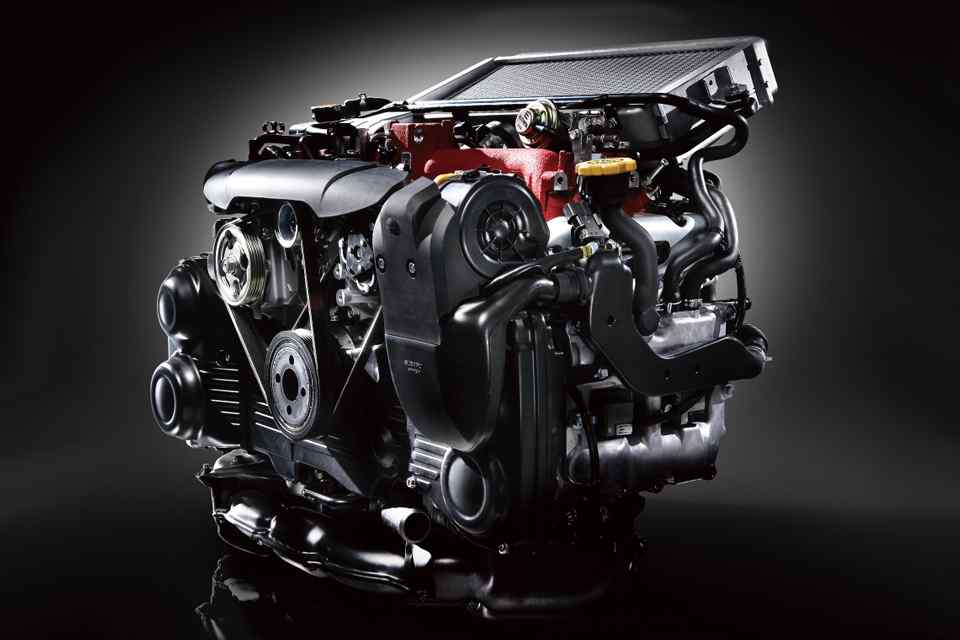
The EJ25’s aluminum cylinder heads, combined with the cast iron block construction, create a bimetallic junction with different thermal expansion characteristics that stress the head gasket system.
While this material combination offers advantages in terms of weight and thermal conductivity, the differential expansion rates create microscopic movement at the sealing surfaces that gradually compromises gasket integrity.
This problem is exacerbated by Subaru’s head bolt design, which initially employed a torque-to-yield system that proved inadequate for maintaining consistent clamping pressure over extended periods.
Subaru’s approach to cooling system maintenance and service intervals initially underestimated the EJ25’s requirements for optimal cooling system health.
The manufacturer’s recommended coolant change intervals were too long for the engine’s specific characteristics, allowing coolant degradation and the formation of corrosive deposits that accelerate head gasket failure.
Additionally, the cooling system’s design makes proper air bleeding challenging, particularly given the horizontal orientation that naturally traps air in various system components.
The EJ25’s water pump design, while generally reliable, contributes to cooling system problems through its timing belt drive system. When the timing belt fails a common occurrence if maintenance intervals are extended, the water pump stops circulating coolant, leading to immediate overheating and catastrophic head gasket failure.
This interdependence between timing belt maintenance and cooling system integrity creates a critical maintenance requirement that, if neglected, results in expensive engine repairs.
Environmental factors significantly impact EJ25 coolant consumption rates, with engines operated in cold climates showing accelerated head gasket degradation due to extended warm-up periods and frequent thermal cycling.
The engine’s tendency to operate at relatively low temperatures during normal driving creates conditions where the cooling system never reaches optimal operating efficiency, leading to incomplete combustion, increased moisture in the cooling system, and accelerated seal degradation.
Real-world experience with EJ25 engines consistently demonstrates predictable coolant consumption patterns that typically begin around 100,000 miles and progressively worsen until head gasket replacement becomes necessary.
Subaru owners regularly report gradually increasing coolant consumption, beginning with minor top-ups between service intervals and eventually progressing to significant daily consumption that makes the vehicle inoperable.
4. Jaguar AJ-V8 4.0L (1996-2003)
The Jaguar AJ-V8 4.0-liter engine represents a fascinating study in how ambitious engineering goals can create systematic cooling system problems when implementation doesn’t match the theoretical design objectives.
This all-aluminum V8, developed as Jaguar’s flagship powerplant for the XK8 and XJ8 model lines, was intended to combine high performance with luxury car refinement while offering improved reliability over previous Jaguar engines.
Unfortunately, the reality proved quite different, with chronic coolant consumption issues that plagued owners throughout the engine’s production run.
The AJ-V8’s coolant consumption problems stem from fundamental design decisions that prioritized performance and packaging over long-term cooling system integrity.
The all-aluminum construction, while offering significant weight savings and improved thermal conductivity, was implemented without adequate consideration for the thermal expansion characteristics that would affect sealing surfaces throughout the engine’s operational life.
The engine’s relatively short deck height, necessitated by packaging requirements in Jaguar’s luxury cars, created a compact combustion chamber design that generates significant thermal stress on the head gasket system.
The head gasket system represents the primary failure point in the AJ-V8’s cooling system integrity. Jaguar employed a composite head gasket design that, while technologically advanced for its era, proved inadequate for the engine’s specific thermal and pressure loads.
The gasket construction features multiple layers of different materials, each optimized for specific sealing requirements, but the overall design lacks sufficient thickness and fire ring protection around the combustion chambers.
As the engine accumulates thermal cycles, the various gasket layers begin to separate and lose their sealing properties, allowing coolant to leak both externally and internally.
One of the most insidious aspects of AJ-V8 coolant consumption is the engine’s tendency to develop internal leaks that are difficult to diagnose in early stages.
The engine’s complex internal cooling passages, designed to optimize thermal management, create numerous potential leak paths that allow coolant to enter the combustion chambers without immediate external evidence.
These internal leaks often manifest as gradual coolant loss accompanied by subtle changes in exhaust character, slight power reduction, or contaminated engine oil that may not be immediately obvious to vehicle owners.
The AJ-V8’s cooling system design philosophy reflects Jaguar’s luxury car requirements but creates inherent reliability problems. The system employs a sophisticated dual-circuit cooling design with separate thermostats for each cylinder bank, intended to provide precise temperature control and improved cold-weather operation.
However, this complexity introduces multiple potential failure points and makes proper system maintenance significantly more challenging than conventional single-circuit designs. When one circuit begins to fail, the resulting thermal imbalance accelerates seal degradation throughout the entire cooling system.
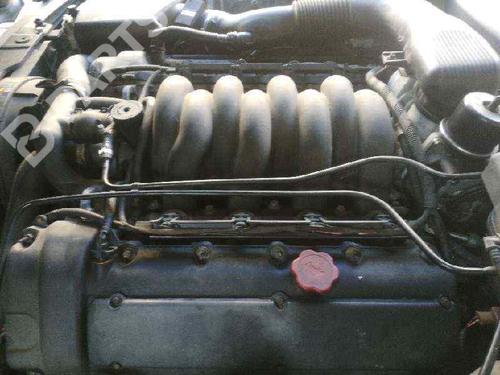
The engine’s aluminum construction creates unique challenges regarding coolant chemistry and corrosion protection. The AJ-V8 requires specific coolant formulations with precise additive packages to prevent galvanic corrosion between dissimilar metals in the cooling system.
Unfortunately, Jaguar’s early service recommendations didn’t adequately emphasize the importance of proper coolant specification, leading to premature seal degradation and accelerated cooling system component failure in many engines.
Generic coolants or incorrect formulations create corrosive conditions that attack aluminum components and rubber seals throughout the system.
The AJ-V8’s water pump design contributes to cooling system problems through its complex multi-stage impeller system and integrated thermostat housing.
While this design provides excellent coolant flow characteristics when functioning properly, it creates multiple potential failure points that can lead to sudden coolant loss.
The pump’s aluminum housing, subjected to constant thermal cycling and coolant chemistry variations, frequently develops porosity or cracking that allows external coolant leaks.
The integrated thermostat housing compounds these problems by creating a large, complex aluminum casting with multiple sealing surfaces that can fail independently.
Jaguar’s approach to cooling system service intervals proved inadequate for the AJ-V8’s specific requirements. The manufacturer’s recommended coolant change intervals were based on luxury car usage patterns that didn’t account for the thermal stresses imposed by the high-performance V8 engine.
Extended service intervals allow coolant degradation and the formation of corrosive deposits that accelerate seal failure throughout the cooling system.
Additionally, the system’s complexity makes proper air bleeding and coolant replacement challenging, often resulting in incomplete service that doesn’t address underlying problems.
The AJ-V8’s tendency to develop cooling system problems is exacerbated by its installation in heavy luxury vehicles that impose significant thermal loads during typical operating conditions.
Unlike sports cars, which are often driven enthusiastically but for short periods, luxury sedans and coupes accumulate extended operating hours at moderate loads that create sustained thermal stress on cooling system components.
This usage pattern, combined with the engine’s inherent design limitations, creates conditions that accelerate seal degradation and promote coolant consumption.
Real-world experience with AJ-V8 engines demonstrates predictable coolant consumption patterns that typically begin around 60,000-80,000 miles and progressively worsen unless addressed through a comprehensive cooling system overhaul. Jaguar owners regularly report initial symptoms including slight coolant loss, intermittent overheating, and gradual performance degradation that eventually progress to complete cooling system failure requiring expensive engine repairs or replacement.
The problem is so widespread that specialized Jaguar service facilities have developed comprehensive cooling system rebuild procedures specifically for AJ-V8 engines, often recommending a complete system overhaul as preventive maintenance rather than waiting for failure to occur.
5. Volkswagen/Audi 1.8T (1996-2006)
The Volkswagen/Audi 1.8-liter turbocharged four-cylinder engine, while celebrated for its performance characteristics and tuning potential, has earned a notorious reputation for chronic coolant consumption that affects virtually every example throughout its operational life.
This engine, which powered numerous VW and Audi models including the Passat, Golf, Jetta, A4, and TT, demonstrates how turbocharged applications can exacerbate inherent cooling system design weaknesses to create persistent reliability problems.
The 1.8T’s coolant consumption issues stem from a combination of design compromises necessitated by the engine’s turbocharged configuration and cost-reduction measures that prioritized initial manufacturing costs over long-term reliability.
The engine’s aluminum cylinder head, combined with a cast iron block, creates a bimetallic junction with significantly different thermal expansion characteristics.
Under the extreme thermal conditions created by turbocharging, these differential expansion rates create microscopic movement at sealing surfaces that gradually compromises cooling system integrity throughout the engine’s operational life.
The head gasket system represents the primary source of 1.8T coolant consumption problems, with design limitations that become apparent under sustained high-load operation typical of turbocharged applications.
Volkswagen employed a multi-layer steel head gasket that, while adequate for naturally aspirated applications, proves insufficient for the thermal and pressure loads generated by forced induction.
The gasket’s fire ring design lacks adequate thickness and heat resistance around the combustion chambers, leading to progressive seal degradation that allows coolant to leak both externally and internally into the combustion chambers.
One of the most problematic aspects of 1.8T coolant consumption is the engine’s complex cooling system architecture, which was designed to manage the additional thermal loads imposed by turbocharging.
The system features multiple cooling circuits with separate paths for the cylinder head, turbocharger, and intercooler, each with independent control mechanisms and potential failure points.
This complexity, while theoretically superior to simpler designs, creates numerous opportunities for coolant leaks and makes proper system maintenance significantly more challenging than conventional naturally aspirated engines.
The turbocharger cooling system represents a particular source of chronic coolant consumption in 1.8T engines. The turbocharger’s oil and coolant cooling circuits share common passages within the turbocharger housing, creating potential cross-contamination points that can lead to coolant loss into the oil system or the external environment.
The turbocharger’s extreme operating temperatures, often exceeding 1,000 degrees Celsius, create thermal stresses that accelerate seal degradation in both the turbocharger itself and the associated cooling system components.

Volkswagen’s implementation of plastic cooling system components throughout the 1.8T engine creates additional reliability concerns that contribute to chronic coolant consumption.
Critical components, including the thermostat housing, coolant flanges, and various pipe connections are constructed from plastic materials that become brittle with age and thermal cycling.
These plastic components frequently develop cracks or complete failures that allow significant coolant loss, often without warning. The problem is exacerbated by the engine’s tendency to operate at elevated temperatures due to turbocharging, which accelerates plastic degradation throughout the cooling system.
The 1.8T’s water pump design contributes to cooling system problems through its timing belt drive system and aluminum housing construction. The pump’s aluminum housing, subjected to constant thermal cycling and coolant chemistry variations, frequently develops porosity or cracking that allows external coolant leaks.
More significantly, the pump’s integration with the timing belt system creates potential for catastrophic failure if the timing belt breaks, as the sudden loss of coolant circulation leads to immediate overheating and head gasket failure.
The engine’s cooling system expansion tank design represents another source of chronic coolant loss that affects virtually all 1.8T engines. The tank, constructed from plastic materials that degrade under thermal stress, frequently develops cracks around mounting points, sensor fittings, or pressure relief areas.
These failures often occur gradually, creating slow coolant leaks that may not be immediately apparent to vehicle owners but result in constant coolant consumption that requires regular top-ups.
Volkswagen’s approach to cooling system service intervals proved inadequate for the 1.8T’s turbocharged application requirements. The manufacturer’s recommended coolant change intervals were based on naturally aspirated engine requirements and didn’t account for the additional thermal stresses and coolant degradation associated with turbocharging.
Extended service intervals allow coolant breakdown and the formation of corrosive deposits that accelerate seal failure throughout the cooling system, particularly in high-temperature areas around the turbocharger and cylinder head.
The 1.8T’s tendency to develop carbon deposits in the combustion chambers, a common characteristic of direct-injection turbocharged engines, creates additional cooling system stress through altered combustion characteristics and increased heat generation.
These deposits change the engine’s thermal characteristics, creating hot spots that place additional stress on cooling system components and accelerate seal degradation.
The problem is compounded by the engine’s sensitivity to fuel quality and maintenance intervals, with poor maintenance practices accelerating both carbon formation and cooling system deterioration.
Real-world experience with 1.8T engines consistently demonstrates predictable coolant consumption patterns that begin relatively early in the engine’s life and progressively worsen over time.
Volkswagen and Audi owners regularly report initial coolant loss around 40,000-60,000 miles, beginning with minor external leaks from plastic components and gradually progressing to more serious head gasket and turbocharger-related consumption.
The problem is so pervasive that aftermarket companies have developed comprehensive cooling system upgrade kits specifically for 1.8T engines, replacing problematic plastic components with more durable alternatives and upgrading cooling system capacity to better handle the engine’s thermal requirements.
Also Read: 5 Gearboxes That Feel New At 150K And 5 That Grind After 50K

